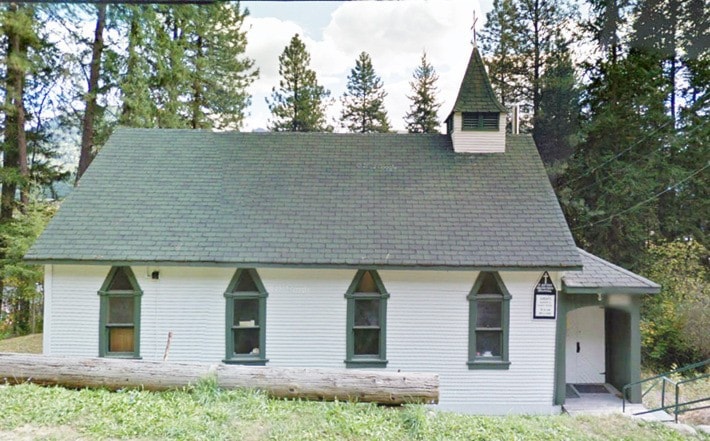After almost 100 years, a South Slocan church will be deconsecrated Sunday and put up for sale. The congregation at St. Matthew's Anglican Church has dwindled to three members and held its last service more than a year ago, said Rev. Ann Wood.
“We’ve gotten used to the idea, but it will be a very sad day. What will happen to it, we don't know.”
Wood, along with warden Sharon Speirs, who lives in Nelson, and treasurer Ruth Hackett, who lives in Slocan Park, have since joined the congregation at St. Saviour’s in Nelson.
Proceeds from the sale of the church, land, and its neighbouring hall will be put toward hiring a full-time priest to serve Nelson, Kaslo, and Balfour.
Atheist decided location
St. Matthew’s was built between 1912 and 1914. But according to a history published in the book Flagship of Kokanee there was some debate over whether it should be located in Bonnington or South Slocan. The latter won by a single vote — reportedly cast by an atheist.
Building began on a plot donated by a Mr. Melneczuk and was done by correspondence. Plans were mailed from England to a volunteer crew, overseen by one paid employee, Talbot Henry Megus, a carpenter and cabinet maker selected because he could read blueprints.
“He had an eye for detail and was very thorough in his work,” the history reads. "On two occasions construction was held up while they waited for the next set of instructions to arrive in the mail.”
After several delays due to slow wartime postal service, the church was completed in September 1914 at a cost of $900, although work was interrupted in 1913 to build a small vicarage next door for the Rev. and Mrs. Kennedy. It’s unclear when the church was actually consecrated.
The church sits on pillars — ten and seven foot cedar posts on the downhill side and four foot posts on the upper side closer to the road, which at the time was the main highway to Nelson. South Slocan Village was then a self-contained ranching community with an hotel, train station, school, store, and laundry.
Two other churches stood nearby: a Roman Catholic Church that still stands but closed in the 1970s and was converted to a greenhouse, and another at Upper Bonnington, St. Mary’s, which has long since been demolished.
St. Matthew’s and St. Mary’s were both part of the parish of Bonnington, in the Diocese of Kootenay, although until 1914, the area fell under the Bishop of New Westminster.
In the 1930s, Bonnington parish became part of the parish of Nelson’s Church of the Redeemer. Also during that decade, a hall was added to St. Matthew’s with a much firmer, concrete foundation. It too was built with volunteer labour, by West Kootenay Power employees.
Unusual font
In 1924, the church acquired a unique baptismal font: a First Nations stone mortar, found on Whiteley’s Island in Ward’s Pool by Mrs. Murray, a member of St. Matthew’s, who donated it to the church.
A local carpenter built a wooden stand for it to be placed on. In 1968, the church was renovated and refurbished, and a wrought-iron stand was created for the font, along with matching flower stands for the sanctuary in memory of Lt. Col. John Murray and his wife, given by their son John, one of the first babies baptized using the font. His three daughters were all baptized there as well.
In 2006, the church donated the font/mortar to Touchstones Nelson for display in its new permanent exhibit of First Nations materials. Members of the Murray family were on hand for the presentation.
Ann Wood and husband Peter moved to South Slocan the year of the church’s rededication. She recalls St. Matthew’s had about 20 regular members then.
“It's never been a flourishing congregation, because it’s only a small community,” she says. “There aren’t many old timers left. It's more a bedroom community now.”
(There is, however, still one church in South Slocan: Junction Covenant Church operates in the former Playmor Hall.)
Over the years, St. Matthews members either died or moved away and Wood, the local priest since 1997, feels it’s time to retire. The last service was in February 2013 and after meeting with the bishop in January, the difficult decision was made to sell. Because the property was never subdivided, the church and hall will be included together. “Who would buy it, I have no idea,” Wood says, adding that the church has power but no water, though the hall has both.
If no one steps forward with an offer and an idea, they may demolish the church rather than let it deteriorate. However, she notes other old churches in the area have been re-purposed. “Churches come and go, really. Mostly go.”
The deconsecration service will be led by the Archbishop of Kootenay, the Rev. John Privett, who suggested that if possible, the altar should be carried out the back of the church as a symbolic ending. But afterward, they will still have to deal with the furnishings.
“St. Saviour’s has enough without ours,” Wood says. “Hopefully other little churches might be able to use it. We’ll perhaps sell the old pews off and on to the holy hardware as we call it. The hard work will begin, I think, after the closing.”
They also have to decide what to do with a century-old organ that hasn’t been used since its pump went, and silverware that is at least 45 years old.
Some church documents dating back to 1912, including a service register, vestry records, and financial records survive in the diocese archives in Kelowna.
Sunday's service begins at 3 p.m. with a reception to follow in the church hall. All are welcome.
